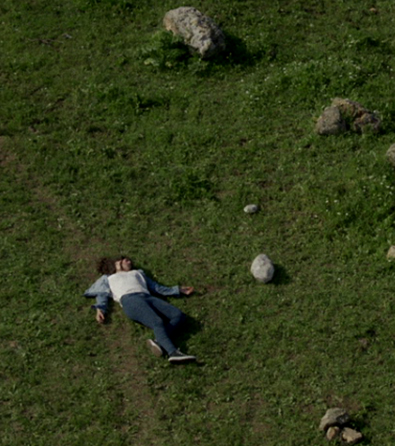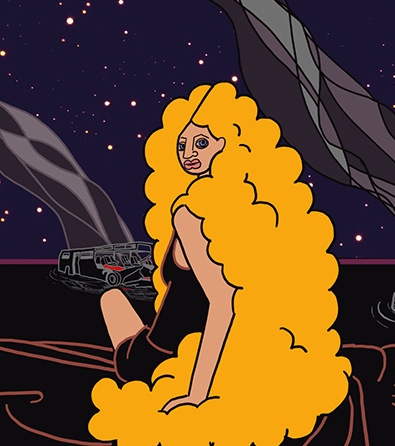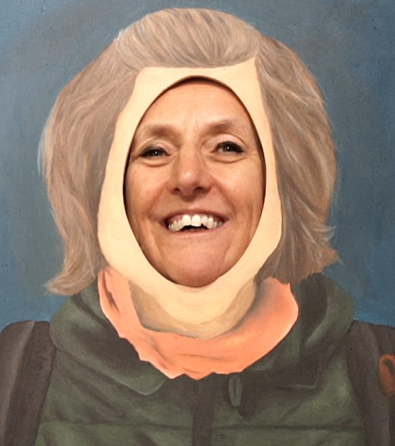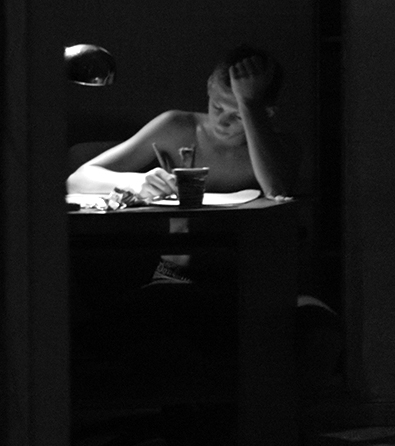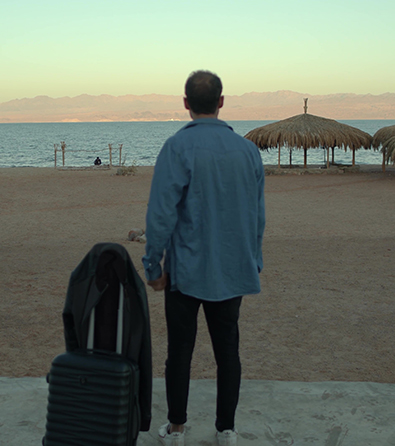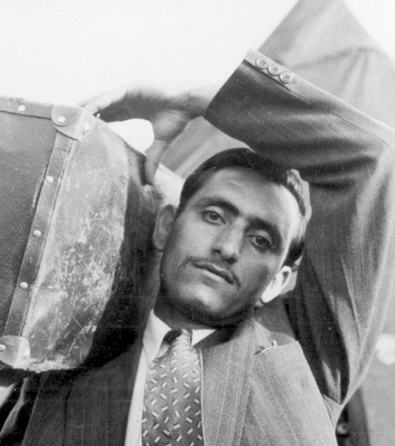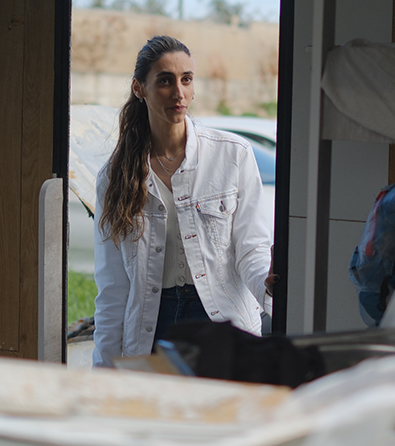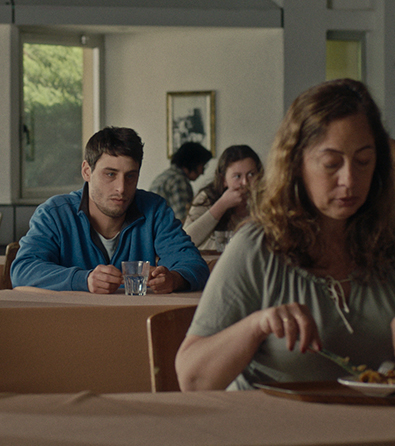The short documentary Fifty Old Dogs (43 minutes) is available at the top of the page.
* To watch this film, please approve YouTube/Vimeo cookies via the blue cookie icon at the bottom left of the screen
The opening shot of Fifty Old Dogs, a documentary by Neta Amiram, who produced, directed, and edited the film, focuses on a dog for a full minute. At first, the shot seems unremarkable: the dog lies still, gazing into the static camera, with the only distinctive feature being the medical cone around its head. Yet, after half a minute of stillness, the dog tries to rise, and it becomes clear something is wrong. The dog drags itself as it moves, revealing a large, partially healed wound on one of its legs. As the shot fades, the film’s title appears, followed by scenes introducing more dogs, each among the fifty old dogs referenced by the title. These dogs also show signs of aging or disability, yet the film deliberately avoids focusing on their infirmities, instead portraying them with the same dignity given to healthy animals. Gradually, the film reveals more dogs, the sanctuary they stay in “Hofshi”, a dog retirement center in Kfar Yehoshua, Israel, and their caretaker, Kobi.
The first part of the film explores the moral dilemmas faced by both the dog owners and Kobi, beginning with phone calls where Kobi explains his services and leading to the arrival of a family with their one-eyed dog. Rather than presenting the families as a single, unified case, the film offers a glimpse into Kobi’s extensive work with different owners, highlighting the emotional weight of making such a life-altering decision. The ethical and emotional complexities of placing elderly or disabled dogs in the retirement home are thoroughly examined: at the core of this dilemma lies the question of whether to opt for surgeries and treatments, resort to euthanasia, or allow the dogs to live out their days in their current state, cared for by Kobi and his dedicated team. Choosing the latter forces owners to confront a difficult compromise, while they may visit their dogs occasionally, the animals will no longer be a part of their everyday lives as before. This predicament resonates for me with a very human counterpart: the struggle of deciding how to care for aging loved ones when their health deteriorates, often resulting in a move to a nursing home. While the portrayal of the dogs is striking on its own, its parallel to human life adds a profound layer of meaning to the discussion.
Another unique aspect of the film is its visual style and the thoughtful use of editing and sound. Neta presents a montage of dogs at the retirement home, while Kobi’s voice in the background describes the uniqueness of the place during a phone conversation. On a denotative level, Kobi’s words are visually matched with images of the dogs and their surroundings. However, on a deeper level, stemming from Neta’s compassionate gaze, the focus becomes the ability to look directly at the dogs’ physical disabilities. The camera does not exploit their limitations to present something extraordinary but instead shows the dogs as they are. The time dedicated to each dog draws the audience in and evokes empathy for them.
This humane perspective brought to mind the documentary film by Persian poet Forugh Farrokhzad, “The House is Black” (1963), which portrays a leper colony in Iran. Farrokhzad blends an objective depiction of leprosy and its treatment with a spiritual reflection on the lives of the colony’s residents. Her camera doesn’t avert its gaze from the physical deformities caused by the disease, often focusing on them in close-ups. Layered over these everyday images are voiceovers of the lepers offering prayers and thanks to God, along with Farrokhzad’s poetry, which she recites. The combination of filmed documentation and voiceover creates a film that seeks to portray the lepers as they truly are, humans with desires, beliefs, and hopes—rather than reducing them to objects of revulsion or pity.
The second part of Fifty Old Dogs focuses on Kobi’s battle with the Ministry of Agriculture, which aims to shut down the retirement home. Closing the facility would mean euthanizing the fifty dogs. The film’s editing and narrative structure become especially significant at this point. First, it allows viewers to form an emotional connection with the dogs. Second, the film shows several dog owners who, after careful consideration, choose to leave their pets at the home, trusting that they will receive the best possible care. This deepens the viewer’s empathy for Kobi’s struggle to keep the retirement home open and preserve the lives of the dogs.
The Ministry of Agriculture’s absurd decision to close the home, despite the owners’ wishes and the retirement staff’s opposition, raises critical ethical questions: Who has the right to decide the fate of those who cannot speak for themselves? Does a person’s desire to keep their pet outweigh the physical hardships the animal endures? Does a person’s love for their dog justify overlooking its suffering? These are complex questions, and while the film doesn’t provide answers, their very presence adds depth to the conversation.
The film reaches its climax on the fateful day when the police are scheduled to take the fifty dogs away. During this time, Kobi and his team are still desperately trying to secure a last-minute delay. The tension in this sequence rivals that of a Hitchcock thriller, heightened by the fact that we are watching real-life events with the dogs’ lives hanging in the balance. Much of this tension is intensified by the choice of camera techniques and the physical distance from the subjects: since Neta and cinematographer Iftach Illouz had to remain at a distance, Iftach filmed the scene from inside the house, using zoom lenses and shooting through the windows. This inability to capture the full scope of the action or get closer to it heightens the sense of helplessness and anguish felt by Kobi, Neta, and the viewers as they watch the events unfold from afar.
In contrast to the clean, static, and carefully composed shots of the film’s first part, the camera here becomes unstable, with the glass windows creating a feeling of peeping and abstraction. The filming and editing amplify the sense of urgency as the dogs are loaded onto trucks. Kobi insists they won’t survive the journey, and the gravity of the situation is immediately clear.
Kobi’s team manages to secure an injunction just in time, and all the dogs are returned to the retirement home. The film then revisits the close-up shots of the dogs, much like the ones seen at the beginning. However, this time, the gaze no longer carries a sense of hope for their survival but rather conveys a growing sense of suffocation. There is a keen awareness that these dogs are living on borrowed time, and at any moment, they could be taken away again.
The film not only raises ethical questions about retirement homes and their significance but also serves as a loving tribute to the memory of these fifty old dogs. The compassionate lens through which they are viewed transforms into a memorial, immortalized by the power of cinema to preserve images in time. As Roland Barthes reflects in “Camera Lucida,” photography freezes time, preserving a moment that is both present and past, capturing what once was and will never be again. “The Photograph does not call up the past, but to attest that what I see has indeed existed” (Barthes 82).
As revealed in the film’s final title card, two months after filming ended, the Ministry of Agriculture returned and took the dogs. Most did not survive the journey, and those who did were euthanized without their owners’ knowledge. Though the dogs are no longer alive, a part of them remains forever within this film.
The graduation film Fifty Old Dogs was produced as part of the Bachelor’s degree program in the Film Department at Minshar for Art in 2021.
